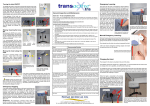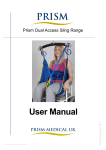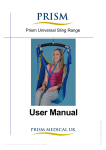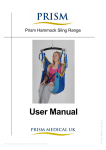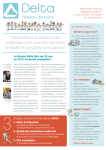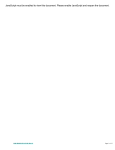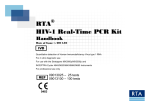Download Cressy Sling User Guide - 01.2013
Transcript
Prism Cressy Sling PL - Prism Cressy Sling User Guide - Doc 009 - Rev 01.2013 © Prism Medical UK 2013 User Manual Prism Cressy Sling The Prism Cressy sling has been designed in conjunction with the M&H team at Derbyshire CC. The continuous shoulder to hip strap allows flexibility in movement should a spasm occur and the person goes into abduction. Application The Cressy Sling provides maximum support to the sacral area. It can be used to transfer from the seated to recumbent position or from recumbent to seated. The person must be assessed by a competent person who must be fully trained in the suitability, application and fitting of the sling. Carers should always be trained in the use of hoists and slings. Sling Inspection All Prism Slings are manufactured to meet and exceed the requirements of BS EN 10535:2006 ’Hoists for the transfer of disabled persons – Requirements and test methods’. Slings should be inspected prior to use and after washing. Damaged or badly worn slings should be discarded. The label on the sling contains vital information to identify the sling - if any part of the label becomes illegible, then it must be removed from service and replaced. The sling should be visually inspected with regard to the following items:• Any signs of damage (i.e. Cuts, frays, tears, burns) to the sling straps • Any signs of stitching becoming undone on any part of the sling • Any signs of the fabric being stretched, tearing or undue wear • Any signs of discolouring or bleaching on the material • Is the sling complete? i.e. all straps present, stiffeners in place - where applicable, etc • Label clearly legible Compatibility The issue of sling compatibility with various manufacturers’ hoists has been a concern for specifiers for a number of years, an issue that is compounded by the increased number of companies supplying hoists and slings. A comprehensive list is available separately and your local agent will be able to provide assistance with compatibility issues. Maximum Load (Safe Working Load - S W L) The maximum load for the sling is clearly marked on the label of the sling. The maximum load will also be displayed on the hoist and any detachable elements of the hoisting system. DO NOT exceed the maximum load stated on any of the equipment. PL - Prism Cressy Sling User Guide - Doc 009 - Rev 01.2013 © Prism Medical UK 2013 Some hoist/sling manufacturers will state that only slings manufactured by them can be used on their hoists and vice versa. This is their policy only and is NOT a legal requirement. A risk assessment must still be completed even if the same manufacturer of hoist and sling are to be used, and the specifier simply has to state that the carry bar is of a similar design and that the sling manufacturer has authorised its use on it. Sling Dimensions A Continuous Shoulder Strap Integral Removable Neck Roll Blue (Black on spacer) B Green Yellow Red Outer Leg Straps White Linking Loop * Binding Removed From Outer Edge for Client Comfort C Navy Blue Inner Leg Loops * A B C Small 680 660 600 Medium 750 680 620 Large 810 730 650 All dimensions have a tolerance of +/- 20mm PL - Prism Cressy Sling User Guide - Doc 009 - Rev 01.2013 © Prism Medical UK 2013 * These loops must NOT be attached directly to the carry bar on the hoist Hoisting from a chair Note: The person to be transferred shall be referred to as “the person”. Bring the leg sections along-side the person’s thighs and pull lightly to ensure that they are of equal length. Note the person has been asked to reach across to raise hip. Using good manual handling techniques, Both leg sections should be the same raise the persons leg and feed the leg length and come through in the same sections under the person’s thighs. position on the clients thighs. Ensure that the leg material is flat without any creases. HOW TO FIT FROM SEATING POSITION b PL - Prism Cressy Sling User Guide - Doc 009 - Rev 01.2013 © Prism Medical UK 2013 Introduce the sling by sliding it down between the chair backrest and the person’s back until the top of the commode aperture reaches the base of the spine. Leave the sling half way down the persons back (don't drape over the persons shoulders) Pass the Navy Blue Inner Leg Loop Pass the Outer Leg Straps through the through the White Linking Loop. Inner Leg Loops. Raise the carry bar just enough to tension the straps and ensure that they are still securely attached. The person can now be raised and transferred. To remove the sling, carry out the fitting procedure in reverse. Important - always peel the sling away from the person to avoid skin friction and movement. Notes • • The above techniques are for guidance only and you must comply with your local policies If in doubt, consult your moving and handling advisor PL - Prism Cressy Sling User Guide - Doc 009 - Rev 01.2013 © Prism Medical UK 2013 Attach the Outer Leg Straps and the Shoulder Straps to the Carry Bar. NOTE: The Inner leg loops and white linking loop must NOT be attached to the carry bar Hoisting from a lying position Raise the persons leg (if possible) and feed the leg sections under the person’s thighs. Ensure that the leg material is flat without any creases. Repeat to both sides. Both leg sections should be the same length and come through in the same position on the clients thighs. Pass the Navy Blue Inner Leg Loop through the White Linking Loop. Pass the Outer Leg Straps through the If using a profile bed, profile the bed to a Inner Leg Loops. sitting position. Ease the back section upwards to ensure that there are no creases in the back section. PL - Prism Cressy Sling User Guide - Doc 009 - Rev 01.2013 © Prism Medical UK 2013 Using good manual handling techniques roll the person towards you so that they are positioned on their side. To introduce the sling, roll half of the sling up underneath itself so that when the person is rolled onto their opposite side, the sling can be unrolled until it is flat. Use the centre rear panel on the back section to ensure that the sling is in line with the person’s spine. Ensure that handle loops are to the outside. Connect the outer leg straps and the shoulder straps to the carry bar. NOTE: The Inner leg loops and white linking loop must NOT be attached to the carry bar Raise the carry bar just enough to tension the straps and ensure that they are all still securely attached to the carry bar. The person can now be raised and transferred. To remove the sling, carry out the fitting procedure in reverse. Important - always peel the sling away from the person to avoid skin friction and movement. Notes • • The above techniques are for guidance only and you must comply with your local policies If in doubt, consult your moving and handling advisor PL - Prism Cressy Sling User Guide - Doc 009 - Rev 01.2013 © Prism Medical UK 2013 Hoisting from the floor Before commencing the manoeuvre, introduce a pillow to ensure the client is comfortable. Follow the procedures as above to fit the sling. If using a mobile hoist, introduce the hoist using the method approved in your local area so that the carry bar is positioned correctly above the client. Connect the sling as shown above ensuring that all checks are completed and hoist the person. Sling position The persons position can be adjusted by simply using a different coloured loop on the outer leg straps. The continuous shoulder strap will self adjust. Person in an upright position using the Person in a slight recline position using Blue loop (Black loop on spacer variant) the Green loop PL - Prism Cressy Sling User Guide - Doc 009 - Rev 01.2013 © Prism Medical UK 2013 Person in a semi-reclined position using Person in a full reclined position using the Yellow loop the Red loop Prism Cressy Sling - Material Variants / Uses Standard Slings Poly: Spacer: The sling is made from a close knit polyester material and has nylon ‘rip stop’ material to the outer side of the leg sections to aid the fitting of the sling. This is a general purpose sling and can be used for sitting and Recumbent transfers between chairs, beds, baths, changing beds, WC’s etc. The sling is made from knitted polyester “spacer” fabric that is manufactured with an ‘air gap’ internally. The material stretches slightly in all directions and moulds perfectly to the shape of the person being hoisted. This is a general purpose sling that can be used as the Poly but has the added benefit of being suitable to be left in position if required (subject to risk assessment and monitoring of pressure risks). CE Marking - Declaration of Conformity Registered Manufacturer No: CA013248 Prism UK Medical hereby declares that the Prism Sling Range meets the provisions of the European Union Council Directive 2007 / 47 / EEC concerning Medical Devices and are classified as Class 1 Devices in accordance with that Directive. Prism Cressy Sling Serial Number…………………………………………. ……………………………. Signed : For Prism Medical UK PL - Prism Cressy Sling User Guide - Doc 009 - Rev 01.2013 © Prism Medical UK 2013 We hereby certify that the products listed above are manufactured, labelled and packaged in accordance with the provisions of Directive 2007 / 47 / EEC and conform in all aspects to the specification(s) relevant to them at the time of despatch and are CE Marked in accordance with Directive 2007 / 47 / EEC . SLING CARE: LAUNDERING GENERAL. Sensitive laundering of lifting slings will extend the service life of the product. Conversely, improper laundering will reduce the service life and possibly affect the strength and integrity of the sling. To be avoided: Use of bleach at washing, particularly hypochlorite [may cause structural damage] • Overheating the sling [temperatures in excess of 100º may cause extreme shrinkage and structural damage] • Use of non-biological detergents is not recommended (especially Fairy Non - Bio): as these types of detergent contain bleaching agents that can degrade the strength of the sling. The use of fabric conditioners is not recommended. Any hook & loop fastenings should be closed prior to laundering to avoid the ‘hook’ side damaging the sling or other items laundered with it. GENERAL SOILING. The sling should be laundered with soap or detergent at 50°C on a standard domestic cycle. DISINFECTION. The sling should be laundered to ensure a ‘period at temperature’ of: 10 minutes at 65ºC 3 minutes at 72ºC • • Following NHS guidelines, extra time should be added to ensure thorough mixing of hot water through the wash load. It may be that available equipment does not allow the required level of temperature control. The sling may be washed on a 90ºC wash cycle, though it is likely that some moderate shrinkage and/or colour bleed will occur. Slings will air dry quite quickly in a warm room. Slings should not be placed over radiators or convectors. Slings may be CAREFULLY tumble dried on a cool [60ºC] setting and short cycle. The sling should be checked at intervals not exceeding 5 minutes. Do not allow the sling to overheat. The sling should last in excess of 5 years if the above guidelines are adhered to. All Prism slings have a manufacturers guarantee of 12 months. PL - Prism Cressy Sling User Guide - Doc 009 - Rev 01.2013 © Prism Medical UK 2013 DRYING. PL - Prism Cressy Sling User Guide - Doc 009 - Rev 01.2013 © Prism Medical UK 2013 Notes SLING SAFETY Care Plan Information All Prism Cressy Slings have space on the labels to record the clients name. Each sling has unique individually colour coded lifting loops on the outer leg straps which helps maintain good lifting practice. The loop options facilitate variable positions from sitting to recline. FIM Score: Date of Assessment : Clients Name: Approx Weight: D.O.B: Type of Sling: Size: Sling Straps Coloured Loop Options Outer Leg Strap Blue/ Black Green Yellow Red Inner Leg Loop Loop Position 1 Loop Position 2 Linking Loop Loop Position 1 Loop Position 2 Comments Prism Medical UK, Unit 4 Jubilee Business Park, Jubilee Way, Grange Moor, Wakefield, WF4 4TD Tel +44 (0) 845 409 2000 www.prismmedical.co.uk [email protected] This document conforms to BS EN ISO 10535:2006 Requirements PL - Prism Cressy Sling User Guide - Doc 009 - Rev 01.2013 © Prism Medical UK 2013 If you have any questions regarding the use of this equipment, please contact Prism Medical UK, or your local authorised dealer.












